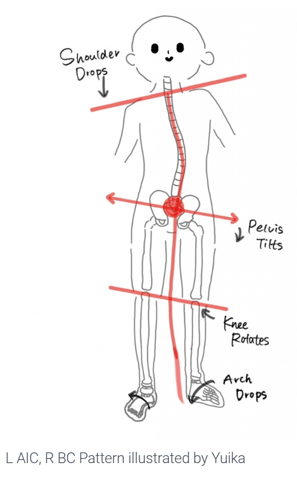Is your Right Hip Higher Than the Left?
Exploring the Postural Restoration Institute and the Left AIC Pattern
Why is your Right Hip Higher Than the Left?
Exploring the Postural Restoration Institute and the Left AIC Pattern
Have you ever noticed that one of your hips seems to be higher than the other? If so, you're not alone. Many people experience this phenomenon, and it can be attributed to various factors. In this post, we will delve into the concept of the right hip being higher than the left, drawing insights from the Postural Restoration Institute (PRI) and the Left Anterior Interior Chain (AIC) pattern.
The Postural Restoration Institute (PRI)
The Postural Restoration Institute is a renowned organization that focuses on the integration of posture, respiration, and neurology. According to PRI, our bodies are inherently asymmetrical, and this asymmetry can manifest in different ways, including the right hip appearing higher than the left.
This asymmetry is primarily attributed to the Left AIC pattern, which refers to the dominance of the left anterior interior chain of muscles. These muscles include the left diaphragm, the left anterior hip muscles, and the left adductor muscles. When these muscles become overactive or imbalanced, they can lead to a lateral pelvic tilt, causing the right hip to appear higher.
The Left AIC Pattern and Lateral Pelvic Tilts
The Left AIC pattern and lateral pelvic tilts can have significant implications for our posture and overall well-being. When the left anterior interior chain becomes dominant, it can pull the pelvis and spine out of alignment. This can result in a variety of aches and pains, including lower back pain, hip pain, and even knee pain.
One of the key reasons for these aches and pains is the altered biomechanics caused by the lateral pelvic tilt. As the right hip elevates, it can create an imbalance in weight distribution and increase stress on certain joints and muscles. Over time, this can lead to overuse injuries, muscle imbalances, and chronic pain.
Furthermore, the lateral pelvic tilt can also affect our gait and movement patterns. As the body compensates for the imbalance, it can lead to altered walking mechanics and potentially contribute to issues such as foot pronation or supination.
Addressing the Right Hip
Addressing imbalances may involve a combination of bodywork, corrective exercises, and postural retraining. The goal is to restore balance and alignment to alleviate the aches and pains associated with the right hip being higher than the left.
Additionally, incorporating practices such as diaphragmatic breathing, core strengthening exercises, and postural awareness into your daily routine can also be beneficial in addressing the underlying muscular imbalances and promoting overall postural health.
In conclusion, the right hip appearing higher than the left can be attributed to the Left AIC pattern and lateral pelvic tilts. Understanding the role of the Postural Restoration Institute and the impact of these imbalances on our bodies can help us address any aches and pains associated with this asymmetry. Remember, seeking professional guidance and adopting a holistic approach to postural restoration is key to achieving optimal well-being.
Postural Restoration Institute
Click below for more info. on PRI



